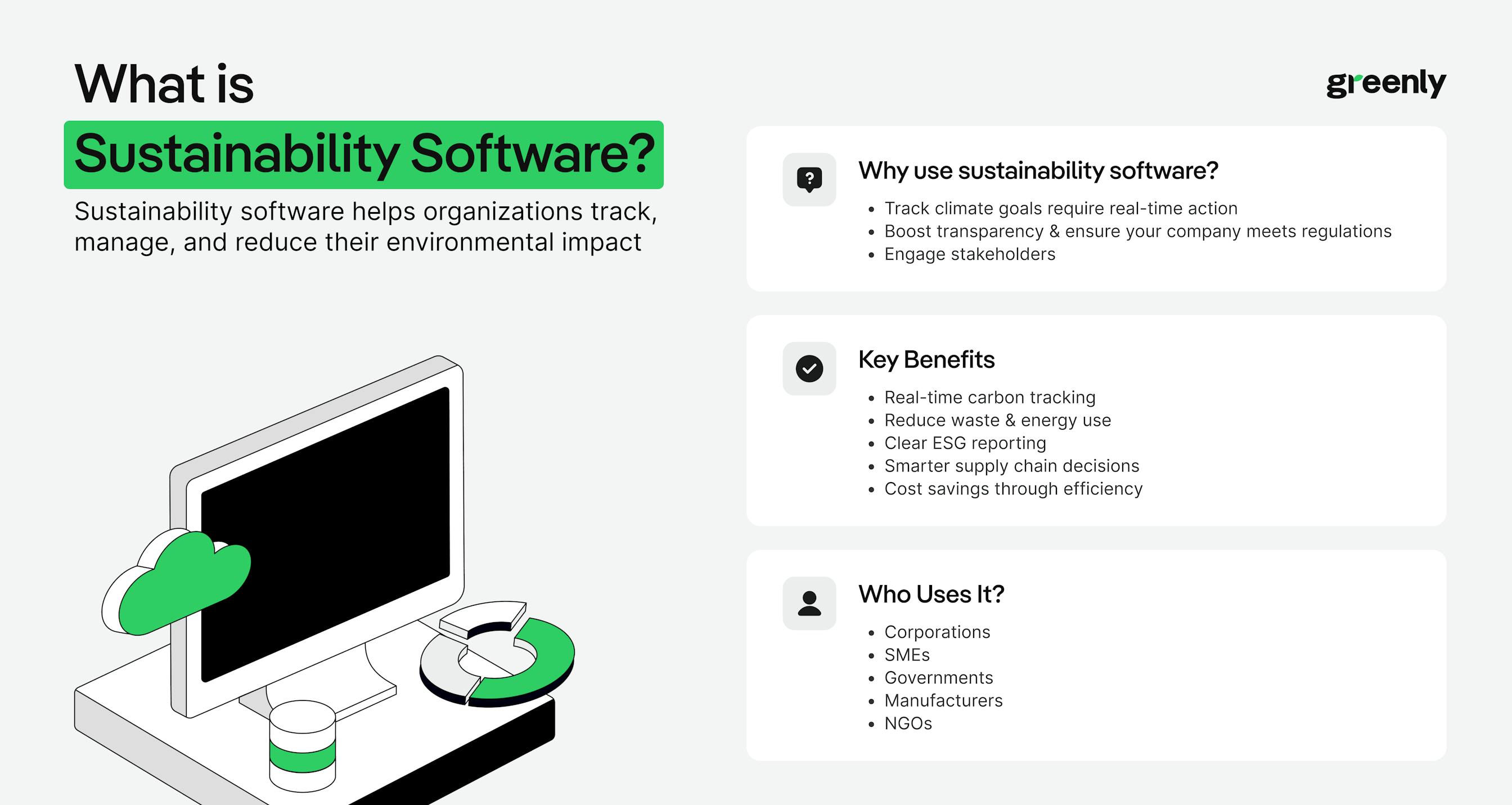
What are the 3 Pillars of Corporate Sustainability?
In this article, we'll explore what the 3 pillars of corporate responsibility are, why they're important, and how businesses can turn them into practical action.
ESG / CSR
Industries



What a sustainability strategy is
The importance of a sustainability strategy in this age of climate change
How to curate a sustainability strategy well suited for your specific business
Many endeavors in the business world are optional, but one that is becoming increasingly imperative is sustainability strategy – and not just because it can help to save the planet, but because businesses are likely to suffer without a viable plan in place.
In this article, we'll break down what is a sustainability strategy, why is it important that businesses make the time and effort to develop the right sustainability strategy for their business, and what are the consequences if they don’t.
A sustainability strategy, sometimes also referred to as a corporate responsibility strategy, is a set of actions which provide a guideline for companies to pull their focus towards investments and improve performance levels – and also engage their stakeholders. A sustainability strategy will often include ESG principles such as environmental and social issues, in addition to the economic impacts of a company’s activities. Ultimately, a sustainability strategy can help companies to cultivate greater value without causing harm to the environment or society.

A good sustainability strategy always starts with a company determining their main mission focus and reasoning for creating the business in the first place. This helps companies develop the appropriate and most suitable sustainability strategy for their business.
In order to curate a viable sustainability strategy, companies must be determined to focus on the issues which pertain to their company the most – and be willing to work through complex situations for the sake of sustainability.
One of the most crucial parts to any sustainability strategy is to implement goals and initiatives that will help to encourage sustainability across the company. Examples of this include creating a plan to actively reduce greenhouse gas emissions, reduce superfluous consumption of finite materials, seek to implement energy efficiency wherever possible, cultivate a sustainable supply chain, and aid in supporting society in whichever way possible.
However, this is not a definitive list, and there is much more that can be done to implement a sustainability strategy – as different strategies are likely to work best for different companies.
Companies cannot achieve their goals if they don’t properly set them in the first place. This is the first and most imperative step to a successful sustainability strategy.
Identify and encourage stakeholders (employees, customers, investors, suppliers, and communities) to share concerns and align business values with the mission.
Risk assessment and management are key — monitor ESG risks to stay aware of potential roadblocks and stay key to a resilient supply chain.
Transparency matters. Disclose emissions and share sustainability progress to cultivate greater trust among stakeholders.
Partner with businesses, organizations, and even governmental bodies to improve reputation and promote sustainability.
Stay adaptable as the world and company evolve. Continuously improve and remain eager to implement new ideas and technologies.
Ultimately, a viable sustainability strategy will not only benefit the company in question, but also help to improve the surrounding environmental and societal circumstances.

In today’s world, a sustainability strategy is more important than ever – as it can provide a wide array of benefits to companies such as helping to attract and keep stakeholders engaged in the company, create opportunities for creativity, and lead to long-term financial success and a more resilient supply chain.
The interactive flip cards below (move cursor over card to flip) will reveal some of the reasons why a sustainability strategy is important:
However, a sustainability strategy is not just a cherry on the cake anymore – it’s becoming something all companies will have to make the effort to adhere to, seeing as the world (government and political bodies, in particular) are growing more aware of the urgent movement to act against climate change.
Think of a sustainability strategy a lot like someone with a lactose intolerance refusing to take a digestive enzyme supplement before eating ice cream. Sure, they can go ahead and have dairy without taking a digestive enzyme first – but it’s pointless to not when the person can. The same goes for a sustainability strategy – even though it isn’t compulsory on paper, it is becoming an implied requirement.
One of the main reasons why a sustainability strategy is no longer an option for companies is because governments and implementing stricter climate legislation and regulations that companies are being required to comply with – and developing a sustainability strategy can help to ensure that companies are ready to adhere at any given moment. This is extremely important given that new environmental legislation is being drawn up, and prevents companies from running around trying to move around business operations for the sake of adhering to these new rules.
We know that it can be confusing on where to start with your sustainability journey, but at Greenly – we've made it easier for you to dive headfirst into the world of carbon emissions with our intuitive software.
Click here to book a demo and start your climate journey with us today!
The infographic below will reveal how sustainability software can work to support your sustainability strategy:


A sustainability strategy can help companies to be proactive rather than reactive – as addressing sustainability issues ahead of time and stay ahead of future environmental and social regulations.
In short, a sustainability strategy is important as it helps companies proceed with their main mission without ignoring environmental and social responsibility. Businesses should care about a sustainability strategy as it can help them to manage risks, improve relationships with their stakeholders, comply with environmental regulations, reduce business costs, and create a successful and sustainable business.

As explained, developing a sustainability strategy can help businesses in a multitude of ways: such as by engaging their stakeholders and promoting sustainability across the company and supply chain as a whole. In the long run, seeking to create a viable sustainability strategy is the better choice in the long run over choosing to not.
Some companies may find bypassing the benefits of a sustainability strategy easy, or may not view developing a sustainability strategy worth their time or financial resources – but overlooking the consequences could prove more challenging.
The battle cards below will reveal some of the pros and cons of developing a sustainability strategy:
Consequences of not developing a sustainability strategy include bad business reputation, supply chain that lacks resilience, poor management of finite resources, less engagement on behalf of stakeholders, and decreased customer and investor satisfaction or interest in financially supporting the business. In addition to this, many governments around the world are making sustainability reporting more compulsory – such as with the SEC disclosure rule and the CSRD. Failure to comply could give companies a bad name and cost them financially with hefty fines.
In the end, companies who seek to implement a sustainability strategy will help their companies from lagging behind from complying with environmental regulations and standards in the future.
The choice is clear: governments, customers, and investors are all in favor of companies who value developing a sustainability strategy over those that don’t.

If businesses want to stay ahead of the curve, they’ll take the plunge and start to develop a sustainability strategy – if they don’t already have one. Often, developing the perfect sustainability strategy is best when done with expertise from carbon accounting companies like Greenly. However, it’s not impossible for companies to set out and develop a sustainable strategy on their own.
That being said, it’s important to keep in mind that curating a sustainability strategy is complex and is best done with third party assistance.
The vertical timeline below will reveal the five key steps to building a sustainability strategy:
All sustainability strategies should start with companies seeking to identify their main missions, values, and the future for their company. This helps companies to shape the best sustainability strategy possible, so that their tactics can remain in line with the company’s original mission.
The crucial points for companies to focus on are going to differ depending on their set of values – to tackle world hunger or protect ocean life is likely to be contingent on what the company already focuses on. For example, a restaurant may be more likely to fight against food waste and a surf-lesson company may be more inclined to contribute to a program to protect ocean life. However, before this commitment can be made – companies have to rationalize their available materials and resources before moving forward with benefiting the environment or society whilst still conducting their business.
It is crucial for companies to create a hierarchy of the social, environmental, and economic issues that matter the most to them. This helps to develop the framework for a sustainability strategy. Ultimately, a good prioritized list should demonstrate how the company plans to tackle each individual issue.
Setting targets is essential for any successful sustainability strategy, as in today’s society – stakeholders nearly expect companies to be able to demonstrate their achievements in some sort of tangible manner. In addition to this, goals allow companies to continue working towards progress in their sustainability journeys.
After all of the above has been completed, companies can then move forward with ways on how to achieve their goals whilst still remaining in line with their values This will include keeping the opinions of employees and other stakeholders in mind, being open to external feedback, and completing continuous reviews to adjust goals accordingly.
At the end of the day, a sustainability strategy is becoming a lot like proofreading a paper that’s already been checked by autocorrect – it may seem fine to turn it in as is, but going the extra mile can certainly prevent mindless errors in the long run.
The same goes for a sustainability strategy, and if companies want to avoid scrambling to comply with the expectations of environmental regulations and stakeholders – they’d be wise to get started now.
If reading this article about why sustainability strategy is no longer optional for companies has made you interested in reducing your carbon emissions to further fight against climate change – Greenly can help you!
Developing a personalized sustainability strategy that’s just right for your company can be difficult on you own, but don’t worry – Greenly is here to help! Our climate experts will help you step by step to curate the perfect emissions reduction and sustainability strategy for your business. Book a demo with one of our specialists today to see how we can help you get started in your climate journey.
Greenly can help you make an environmental change for the better, starting with a carbon footprint assessment to know how much carbon emissions your company produces.